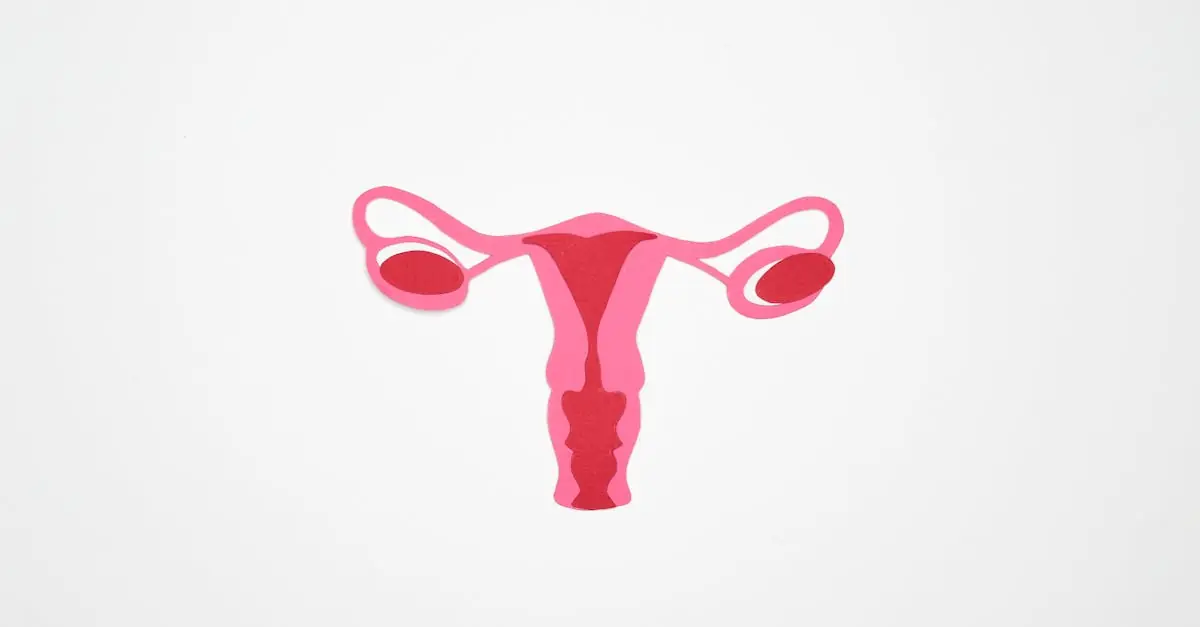Ovarian cysts might sound like a character from a sci-fi movie, but they’re actually quite common and often harmless. Picture this: tiny fluid-filled sacs throwing a party on the ovaries. Most of the time, they crash the scene without causing any ruckus, but sometimes they can be a bit of a drama queen. Understanding these little troublemakers is crucial for anyone who wants to stay informed about their reproductive health.
While the thought of cysts might make some cringe, knowledge is power. With the right information, they can navigate the ups and downs of ovarian cysts like a pro. So grab a comfy seat and get ready to dive into the fascinating world of ovarian cysts, where humor meets health, and clarity reigns supreme. Who knew learning about cysts could be this entertaining?
Table of Contents
ToggleOverview of Ovarian Cysts
Ovarian cysts are prevalent among women, particularly during their reproductive years. Typically, these fluid-filled sacs form on the ovaries, often without causing any symptoms. Many cysts are functional, developing as part of the menstrual cycle. Some women may experience minor discomfort or irregular menstrual cycles, yet most cysts resolve independently.
Various types of ovarian cysts exist, including dermoid cysts, endometriomas, and cystadenomas. Dermoid cysts can contain various tissues such as hair and skin. Endometriomas arise from endometriosis, where uterine tissue grows outside the uterus. Cystadenomas originate from the ovarian surface and can be filled with either a watery or mucous substance.
Complications can occur, although they are rare. Larger cysts may lead to pressure symptoms or rupture, requiring medical attention. Ultrasound examinations often aid in diagnosing cysts, providing crucial details for monitoring.
Treatment options depend on factors such as cyst type, size, and symptoms. Observation is common for asymptomatic cases, while hormonal contraceptives may help manage functional cysts. Surgical intervention is sometimes necessary for larger or problematic cysts.
Knowledge about ovarian cysts empowers women to maintain reproductive health. Being informed reduces anxiety surrounding diagnosis and potential treatment options. Regular check-ups and discussions with healthcare providers support proactive approaches to managing ovarian cysts.
Types of Ovarian Cysts
Ovarian cysts fall into two main categories: functional cysts and pathological cysts. Understanding the differences between these types aids in effective diagnosis and treatment.
Functional Cysts
Functional cysts are the most common variety. They form during the menstrual cycle and usually resolve without intervention. Follicular cysts arise when an ovarian follicle doesn’t release an egg during ovulation, leading to fluid accumulation. Corpus luteum cysts develop after the follicle releases an egg when the structure fills with fluid instead of dissolving. Most functional cysts are harmless and asymptomatic, with many women unaware they exist unless detected during routine examinations.
Pathological Cysts
Pathological cysts are less common and may require medical attention. These cysts encompass dermoid cysts, which contain various tissue types, and endometriomas, linked to endometriosis, where tissue similar to the uterus forms outside it. Cystadenomas, another subtype, originate from the cells covering the ovary and can become quite large. While many pathological cysts don’t cause problems, some can lead to pain or complications, making it essential to monitor their size and symptoms closely. Diagnosis often involves imaging tests like ultrasounds to assess their nature and impact on ovarian health.
Symptoms of Ovarian Cysts
Ovarian cysts can present various symptoms, which often depend on their size and type. While many cases remain asymptomatic, awareness of potential signs is important.
Common Symptoms
Discomfort may occur in the lower abdomen during activities such as exercise or sexual intercourse. Pain experienced ranges from mild to severe. Women might notice irregularities in menstrual cycles, including late or missed periods. Bloating or swelling in the abdominal area can result from cyst formation. Pressure on the bladder can cause frequent urination, while pressure on the rectum may lead to changes in bowel habits. Some might experience lower back pain, especially if the cyst grows larger.
When to Seek Medical Attention
Consulting a healthcare provider becomes essential if sudden or severe abdominal pain arises. Increased pain that does not improve over time may indicate complications, requiring immediate evaluation. Persistent bloating and noticeable abdominal swelling should prompt a medical assessment. Additionally, nausea or vomiting accompanying pain signals a need for urgent care. Any symptoms of abnormal bleeding or menstrual changes that last longer than usual warrant professional attention. Regular monitoring and open conversations with healthcare providers help in managing ovarian health effectively.
Diagnosis of Ovarian Cysts
Diagnosing ovarian cysts involves various imaging techniques and laboratory tests to determine their type and potential impact on health.
Imaging Techniques
Ultrasound serves as the primary imaging method for assessing ovarian cysts. This non-invasive procedure uses sound waves to create images of the ovaries, allowing healthcare providers to evaluate cyst size and appearance. Transvaginal ultrasound offers a closer view and can provide more detailed information compared to abdominal ultrasound. Magnetic resonance imaging (MRI) is another option, particularly useful for complex cysts. CT scans may occasionally assist in identifying larger cysts or evaluating symptoms that suggest complications.
Laboratory Tests
Blood tests play a crucial role in diagnosing ovarian cysts. Healthcare providers may check levels of the tumor marker CA-125, which can indicate the presence of certain ovarian conditions. Elevated CA-125 levels warrant further evaluation, especially if accompanied by concerning symptoms. Pregnancy tests confirm or rule out ectopic pregnancies that may mimic cyst symptoms. Hormonal tests assess hormonal imbalances that can lead to cyst formation, guiding treatment strategies based on individual results.
Treatment Options for Ovarian Cysts
Various treatment options exist for managing ovarian cysts, depending on their type, size, and symptoms. Understanding these options allows women to make informed decisions regarding their reproductive health.
Watchful Waiting
Watchful waiting serves as a common approach for managing functional cysts. This method involves monitoring the cyst without immediate intervention. Over 75% of functional cysts resolve on their own within a few menstrual cycles. Regular follow-ups with a healthcare provider ensure that any changes are noted. If symptoms arise, medical advice can help decide on further action.
Medications
Medications often play a role in the treatment of ovarian cysts. Hormonal contraceptives frequently help regulate menstrual cycles and prevent new cysts from forming. In cases of pain or discomfort, nonsteroidal anti-inflammatory drugs can provide relief. Additionally, hormone therapy is sometimes suggested for managing endometriomas or cysts related to endometriosis. These medications aim to minimize symptoms and reduce the recurrence of cysts.
Surgical Interventions
Surgical interventions may become necessary for larger or complicated cysts. Laparoscopy is a minimally invasive technique used to remove cysts or ovaries when needed. This procedure often results in quicker recovery and less scarring. For very large or persistent cysts, laparotomy may be performed to ensure complete removal. Diagnosis and previous monitoring help determine the best surgical approach, ensuring effective treatment and preserving ovarian health.
Lifestyle and Home Remedies
Maintaining a healthy lifestyle can aid in managing ovarian cysts. Incorporating a diet rich in fruits, vegetables, and whole grains supports overall health. Various vitamins and minerals, particularly vitamin D, play crucial roles in reproductive health. Regular physical activity also helps regulate hormones and reduces stress levels.
Staying hydrated proves essential for bodily functions. Water aids digestion and helps prevent bloating associated with ovarian cysts. Consider herbal teas known for their anti-inflammatory properties. Peppermint, chamomile, and ginger tea can offer relief from discomfort.
Practicing stress-reduction techniques benefits those with ovarian cysts. Activities like yoga and meditation can enhance emotional well-being while promoting relaxation. Deep breathing exercises also support mind-body connection and reduce anxiety.
Regular check-ups with a healthcare provider ensure any changes in cysts are monitored. Keeping track of menstrual cycles helps identify irregularities. Those affected can journal symptoms to discuss with their doctor during appointments.
Using heat pads may provide temporary relief from abdominal discomfort. Applying heat can relax muscles and soothe cramping. Over-the-counter pain relievers, such as ibuprofen, can also help manage mild pain.
Some women find that natural supplements improve their symptoms. Omega-3 fatty acids and evening primrose oil have shown potential benefits. Consult with a healthcare provider before starting any supplements to ensure safety and efficacy.
Through these lifestyle adjustments and home remedies, managing ovarian cysts becomes more approachable. Emphasis on a balanced lifestyle not only aids in dealing with ovarian cysts but also enhances overall reproductive health.
Ovarian cysts are a common aspect of reproductive health that many women encounter. While most are harmless and resolve on their own, awareness of their symptoms and types is essential for proactive health management. Regular check-ups and open dialogue with healthcare providers empower women to navigate their reproductive health confidently.
Incorporating lifestyle changes and home remedies can further enhance well-being and alleviate discomfort. By staying informed and attentive to their bodies, women can effectively manage ovarian cysts and maintain a healthy reproductive system.



